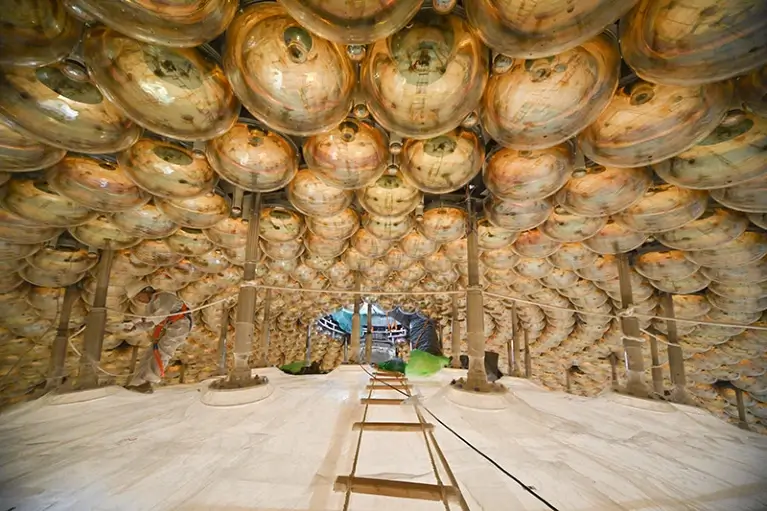The facility, named JUNO, consists of a huge tank that surrounds an array of detectors. The container contains a substance that causes a scintillation which is recorded in the detectors and thus allows to identify a neutrino event, its type and mass, since the neutrino particles change into different types upon their formation

In China's giant underground neutrino lab, a facility called JUNO is ready for action. Its purpose is to study the mass of neutrinos, small and mysterious elementary particles found in the universe. The station in Jiangmen is expected to help solve the puzzle of the mass order of the neutrino, that is, to determine which type of neutrino is heavier.
JUNO's neutrino detector is designed to observe neutrinos coming from nearby nuclear power plants, as well as from other natural sources such as the Sun and geological processes within the Earth. The basis of its technology is a detector in the form of a ball with a diameter of 35 meters, which is a container weighing 20 tons, inside of which there are scintillator liquids. This liquid emits light when neutrino particles penetrate it and collide with atoms within the liquid, allowing the detector to record the events.
The technology of neutrino detectors like JUNO is required to be particularly sensitive, since the neutrino particles are very little interactive with other matter. In fact, many of them pass through the Earth without any interaction. To detect those particles that do pass through the liquid, it is necessary to test the liquid scintillator to ensure that it is free of impurities, so that the radioactive background tissue is as low as possible.
Thousands of advanced photon detectors (photon hunters) are installed around the tank whose purpose is to detect the light emitted from the scintillator due to interaction with neutrinos. Each oscillation of light is recorded and data analysis allows researchers to derive information about the neutrino, such as energy, direction of motion, and identity.
The collected information is transferred for analysis in advanced computer systems. By using mathematical and physical models, the scientists analyze the data and draw conclusions about neutrino properties, such as the order of mass and the different appearance of neutrino types (formation).
Juno will receive neutrinos from various sources, but mainly from two nuclear power plants located more than 50 kilometers from the facility. These neutrinos are part of the radiation emitted during the nuclear fission process at the stations. Thanks to the fixed and known distance in advance, the scientists can calculate the probability of the occurrence of a change in the type of neutrino during the movement from the source to the detector. This allows the research team to examine the behavior of the neutrino particles over a distance, to know how they behave and to confirm theoretical assumptions about the way they change one type to another.
Neutrinos are part of the Standard Model of particle physics, but their masses and ranges are a fundamental mystery in the universe. By deciphering the mass order of the neutrino particles, the JUNO project will be able to contribute to the understanding of these properties and to an overall improvement of our understanding of the universe.
In the research world of particle physics and astrophysics, neutrino detection facilities allow researchers to tackle some of the most central questions about the universe. JUNO is one of the most important facilities in the international arena, but there are other facilities that face similar challenges or investigate related questions using other technologies. Some of the most prominent among them are:
Super-Kamiokande (Super-K)
Located in Japan, Super-K is one of the world's leading neutrino research facilities. It is an underwater neutrino detector that has been operating since 1996. In fact, the Super-K neutrino discoveries contributed critical evidence that neutrinos have mass, leading to the 2015 Nobel Prize in Physics.
IceCube Neutrino Observatory
Located south of the South Pole, IceCube is a massive-scale neutrino detector based on ice. It is designed to detect high-energy cosmic neutrinos from neutrinos originating in the Earth's atmosphere or the Sun. IceCube sheds light on astrophysical processes far away in the universe and was used to identify external sources of cosmic neutrinos.
T2K (Tokai to Kamioka)
Another facility in Japan, T2K is an experiment that detects neutrinos that are sent from a facility in Tokai to a detector in Kamioka, to measure transformations between types of neutrinos. This experiment provides insights into the transformations of neutrinos during their movement in space, which allows researchers to learn more about the basic properties of these particles. This facility is expected to start operating in 2027.
DUNE (Deep Underground Neutrino Experiment)
The DUNE detector, currently under construction in the United States, is intended to be one of the largest and most sophisticated neutrino facilities in the world. With its future location in the depths of the Sanford Underground Research Facility in South Dakota, DUNE's goal is to analyze the neutrinos coming from the Fermilab particle accelerator in Illinois about 1300 kilometers away. DUNE is designed to investigate the splitting and merging processes of neutrino particles and provide insights into symmetry between matter and antimatter, as well as the role of neutrino particles in cosmological evolution.
Each of these facilities, together with JUNO, contributes in its uniqueness to the complex of scientific knowledge about neutrino particles and opens a window to new chapters in the understanding of the universe.
More of the topic in Hayadan:
- What a class, I have an essay! – Nobel Prize in Physics for the scientists who revealed the secrets of neutrinos
- For the first time, a neutrino particle has been detected that came to us from the vicinity of a supermassive black hole
- Ghost ripples in space
- The neutrino puzzle
- Particles from space deep in the ice
